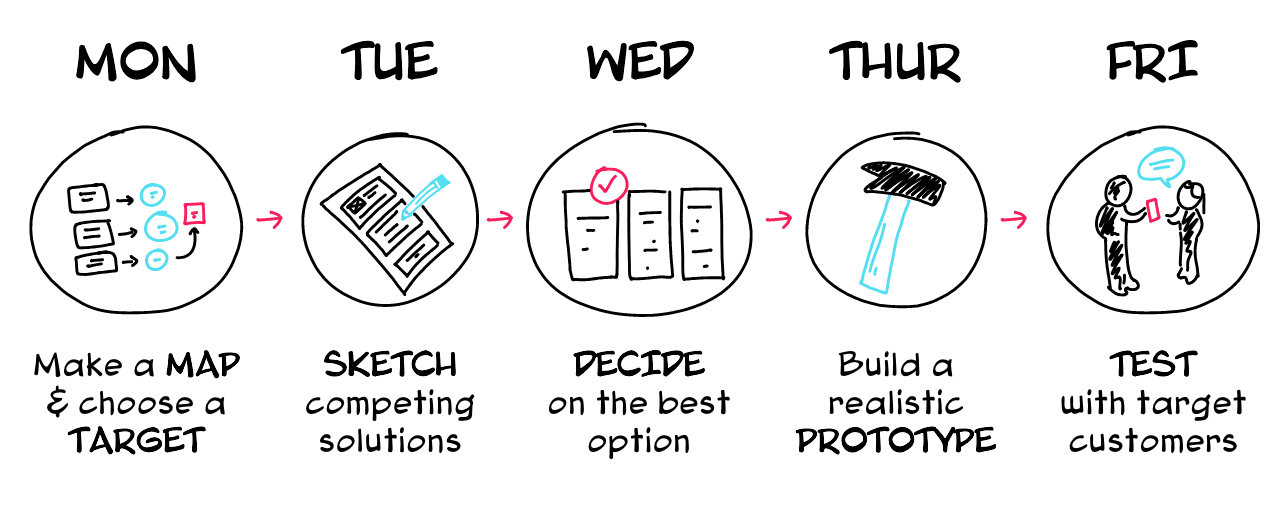Design Sprint is essentially a design methodology that vies for attention. And “Sprint” in terms of design – indicates time constraint. Remote Design Sprint is gaining immense popularity amongst designers and project managers. Why?
Because it works!
The primary goal of running remote team Design Sprints is to focus on a problem and generate multiple solutions for it by building prototypes and getting feedback from the users – which helps businesses innovate and make strategic decisions swiftly.
The literal meaning of the word “sprint” is a run. A sprint takes place over a long period and if everything goes well, the results can be highly rewarding.
Even when everyone in the same location, running remote design thinking sprints is challenging, and when teams shift to working remotely, it can become even more demanding.
Since the time this concept came into the market, several companies and agencies have picked up the process and are using it to build phenomenal designs.
Google, Airbnb, Lego, and Uber are amongst the first and the biggest players to integrate Design Sprints into their workflow.

The Challenges of Running Remote Design Sprints
- Availability of Teams and Time Zone Differences
Scheduling and aligning distributed teams for a long period is often challenging while Sprint requires intense work sessions.
- Low Engagement
When your team is working under the same hood, it is easy to keep them focussed. However, when the team is working remotely, they are just a click away from Netflix or Prime.
- Tech Challenges
All it takes to hijack your remote session is a poor internet connection, low battery, or an unreliable microphone.
So, what is the right blend of tools and techniques to make remote Design Sprints feasible?
How To Run Successful Remote Design Sprints?
The Sprint structure in itself is the biggest challenge in running Remote Sprints.
The remote version of the Design Sprint features a combination of synchronous and asynchronous sessions, which allow for better flexibility. Here’s our remote Design Sprint schedule:

Essentially, the first 2 working days are workshop days that involve the entire team. Sessions are further broken down into parts. Day 3 is used to prototype the solution and Day 4 is generally for testing.
A Three-step Process for Running and Facilitating Effective Remote Design Sprints!

How to conduct a Remote Design Sprint smoothly?
- Rigorous preparation
- The right choice of tools
- Proper facilitation
STEP 1 – Rigorous Preparation
Not preparing enough is the best way to destroy a Design Sprint even before you create it, especially when running remote team Design Sprints
Although some may believe that planning in advance could be counterproductive as a Sprint is based on free-flowing ideation – A sprint still needs to be pursued under controlled circumstances.
Define the Problem
Once you have planned the Design Sprint, it is time to be conversant with the challenge. Make sure you keep the key stakeholders in the loop and all the team members are clear of the outcome.
Build the Design Sprint Team
A team of 5-7 professionals is apt and choosing the right resources is crucial for the success of the Design Sprint. Sprint aims to get the right people to focus on a specific problem and generate solutions.
Schedule the Sprint
For a running successful remote Design Sprints, consider scheduling all the resources within the nine-hour window across timezones.
Create a Design Sprint Brief
Consider using templates to create Design Sprint briefs. This document would help align all the resources on what to expect from the Sprint. In the template, include the following:
Outline of the challenge, the schedule, the time frame, and a checklist of things to do.
Frame the Problem
When running remote Design Sprints, it is vital to frame the problem. How? You need to do ample research around the challenge.
Based on the challenge, consider looking into analytics, conducting audits, or even interviews. This process will help the remote team to aligned before the Design Sprint starts.
STEP 2 – The Right Choice Of Tools
To run remote Design Sprints swiftly, having the right tools is imperative. Check out these best tools to use:
- Doodle: Schedule meetings.
- Miro: Build and develop ideas with a collaborative whiteboarding platform.
- Asana: Easily manage team projects and tasks.
- Zoom: Connect, chat, share screens, and record sessions seamlessly.
- Notion: Keep everything in one place, from notes and tasks to prototypes.
- Figma: Prototype and collaborate across timezones online.
- UserTesting: Get rapid feedback on prototypes.
STEP 3 – Proper Facilitation
Running seamless remote Design Sprints requires proper facilitation.
Work Area For Every Resource
Creating an individual and an independent work area for every resource in the team can help increase productivity and overall efficiency. Doing this enables team members to remain focussed, giving a clear view of progress.
Comprehensible Explanations and Instructions
Make sure all your resources are aware of their tasks. Instead of repeating what to do time and again, consider placing comprehensible explanations and instructions for each member of the team.
Tips For Running Remote Design Sprints
- A Subdued Call Environment
Work in a quiet place. Don’t let the coffee machine behind you whirr espresso in the background.
- Vidoe Conferences
Regular video calls with the remote team is of immense importance as it’ll become easy for you as a facilitator to spot if any member of your team is disengaged.
- Expectation Management
When running remote team Design Sprints, it is vital to manage the team’s expectations. The team must be able to see an ROI as the team calendar would be blocked for a few days.
The team must be aware and informed of the desired outcome because, in a Deign Sprint, the team doesn’t build the entire product. It’s more about moving in the right direction.
- Staying Organized
It’s a good idea to set up a project in a tool like Asana or Notion where updates can be provided and all relevant materials can be uploaded, so the entire team is connected and understands where to find everything.
How to Kickstart the Next Remote Design Sprint
- Talk to key people in the team and only then begin with the Sprint.
- Choose the right people for the job.
- Build a schedule and confirm the team’s commitment.
- Make use of a template to create a brief for the Design Sprint.
- Use a project management tool.
- Choose the right tools and prepare a virtual sprint room.
- Run the Sprint.
Final Thoughts
Design Sprints were developed by Google to enable teams to align on a specific problem, generate multiple solutions, create and test prototypes, and get feedback from users in a short period of time.
A well organized Remote Design Sprint has the potential to do wonders for your product. Running remote Design Sprints is surely a little complicated but it can save you a lot of time and resources.
Moreover, in a Remote Design Sprint, including the stakeholders in every meeting is easy. Make sure the participants of the Design Sprint are aware of their roles and responsibilities.
RnF Technologies believes strongly in adapting to new challenges and being open to finding the right solutions. Got a project in mind? Why not test our skills? Let’s discuss it!
FAQs
How do I do a Design Sprint?
The process of a Design Sprint includes – preparation, the right tools, and proper facilitation. Consider defining the challenge, build a team, choose the right tools, schedule a print, manage expectations of your team, and sprint on.
How does Design Sprint work?
The Design Sprint process is essentially a 4-day process apt for solving challenges using design, prototyping, and testing.
What is the Design Sprint process?
Traditionally, a Design Sprint process: understand, ideate, decide, prototype, test, and aim to solve complex problems and reduce risk when designing a new product.
